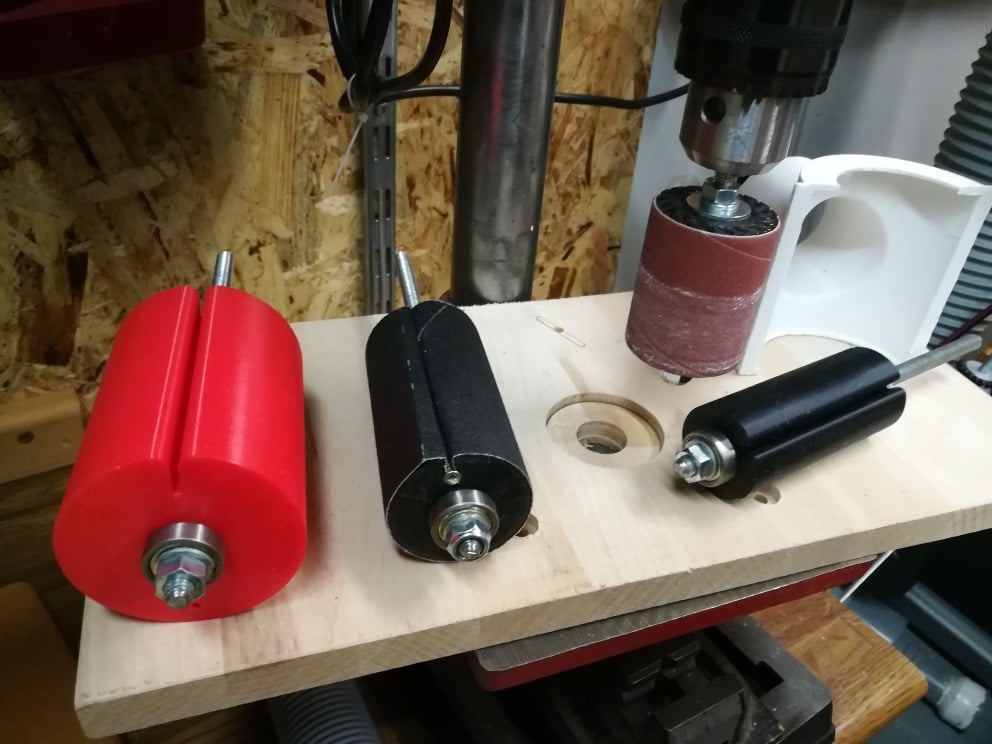
Sanding belt adapter for table drilling machine
thingiverse
Sanding Belt Adapter for Table Drilling Machine Published on March 25, 2019 by Thomas Grinding Roller for Bench Drill from 3D Printer Stand Drill Grinding Adapter Using a Cost-Effective Sanding Belt in a Bench Drill The article discusses using a grinding wheel from the 3D printer in a bench drill. We can now use inexpensive sanding belts instead of expensive sanding sleeves. My initial project was an adapter for the grinding wheels of the Bosch grinder PRR 250. Small adjustments to the construction allowed me to use inexpensive endless grinding wheels, specifically 93mm wide abrasive cloths. To avoid stress with hole saws, this adapter comes from the 3D printer. Adjustments in height and diameter are therefore easy. The abrasive cloths are inserted into the slot and secured on both sides with a screw. For mass balance, there is an opposite hole where, if necessary, a screw can be screwed. The minimum diameter of the grinding wheel should be at least 38mm. There is no space left underneath for the slots to attach the abrasive material. Further material costs are limited to a typical 8mm ball bearing (inliner), M8 threaded rod and nuts. The costs, including 3D printing, are less than €3 per adapter. I would advise against using this in a bench drill without an abutment. If you don't have to pay attention to the bearings, you can also use an old cordless screwdriver/drill. A bench drill is still the first choice. The operating costs are quite low because we can get about 30 sanding sleeves from a 5m roll in a 50mm roll. If we set the price for the roll at €12, we're at 40 cents per sleeve. The grinding sleeves of oscillator grinding machines from Scheppach, Triton and Co are offered for 6 euros each. The whole thing is not as professional as a stationary spindle grinder, but I see the following advantages: * Purchase of a grinding machine is eliminated if you already have a stationary drill. * Any diameter above about 40mm is possible. * A wide range of grinding widths and grain sizes are available. * The abrasive material is cheaper by a factor of 15. * The structure is simple and cannot be broken down to the plastic body. * The workload is minimal thanks to the 3D printer. * The 3D printer gets something to do again. When printing, we don't have to be stingy with material. These walls should be 3 perimeters (1.2mm) and the fill should be 20%. PLA was perfect for me. Whoever manages to bring the grinding wheel above 50°C in operation should use ABS or PETG. The height and, to a lesser extent, the diameter of the grinding wheel can be easily adjusted in the slicer. Otherwise, the model is so simple that you can easily reconstruct it. In case of wear or damage, replace the grinding wheel in time and provide eye protection. Of course, those who distrust the plastic can also produce the wooden grinding wheel with a lathe or a circular saw.
With this file you will be able to print Sanding belt adapter for table drilling machine with your 3D printer. Click on the button and save the file on your computer to work, edit or customize your design. You can also find more 3D designs for printers on Sanding belt adapter for table drilling machine.
